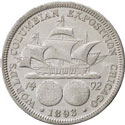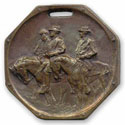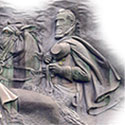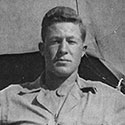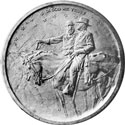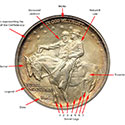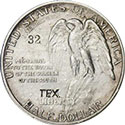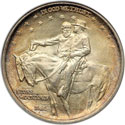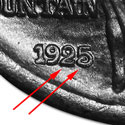
Stone Mountain
Commemorative Half Dollar
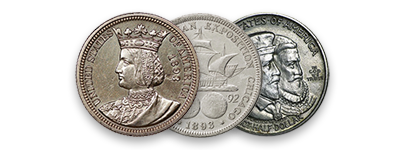
Commemorative
Coins
Because numismatists live in the real world it is difficult to keep personal feelings or current events out of the study of a particular coin, and specifically commemorative coins. But to study a commemorative coin as we might any other, we must set aside those issues and deal with issues of design, production, dies, or errors. There is plenty to study without getting into the politics or events of the day, and there are plenty of forums where one can express their feelings. The Civil War is especially difficult because it pitted friends or close neighbors against each other and, in some rare cases, family members against each other.
Researching Commemorative Coins
 One of the more interesting aspects of researching any commemorative coin of the United States is the lack of information for specific coins. Commemorative coins are usually treated as a category and information is presented as a portion of the topic covering all issues for a time period. The Stone Mountain Half is no different and is usually sandwiched in with other coins issues in the "classic" period from 1893 to 1939.
One of the more interesting aspects of researching any commemorative coin of the United States is the lack of information for specific coins. Commemorative coins are usually treated as a category and information is presented as a portion of the topic covering all issues for a time period. The Stone Mountain Half is no different and is usually sandwiched in with other coins issues in the "classic" period from 1893 to 1939.
This abbreviated presentation makes consistent information about any commemorative issue difficult to find. Each author or collector seems to have a part of the story, or writes only about that portion of the story that is of personal interest. While that may not be unusual, the problem is exaggerated by the abbreviated format. In our research of the Stone Mountain Half Dollar we found this to be of particular concern because the issue of the coin was controversial and some of those feeling still persist.
Commemorative Coin Usage
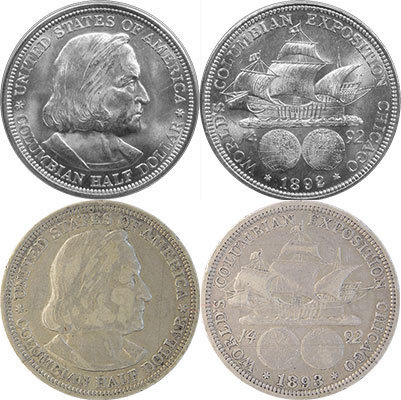 In the United States commemorative coins have been issued since 1893 when the first coin supporting the Columbian Exposition was created. Unlike normal coins issued by the Mint, commemoratives were issued to support a specific event or recognize a specific person. Created under the control of the Mint, the coins were sold to a sponsor at face value and then re-marketed to consumers at a higher than face value price. Commemorative coins are also subject to artistic interpretation more than regular circulating or proof coins. This artistic expression sometimes leads to a less than ideal design, or one that the Mint might not create outside the commemorative event.
In the United States commemorative coins have been issued since 1893 when the first coin supporting the Columbian Exposition was created. Unlike normal coins issued by the Mint, commemoratives were issued to support a specific event or recognize a specific person. Created under the control of the Mint, the coins were sold to a sponsor at face value and then re-marketed to consumers at a higher than face value price. Commemorative coins are also subject to artistic interpretation more than regular circulating or proof coins. This artistic expression sometimes leads to a less than ideal design, or one that the Mint might not create outside the commemorative event.
But earlier silver commemorative coins often made it into circulation for a number of reasons. This wide spread use of them is one of the differentiating features from modern commemoratives which are issued by the Mint and viewed by collectors purely as a collectible and never as a circulating coins. You can spend a modern silver American Eagle for its dollar face value, but it would not be advisable since its melt value is many multiples of its denomination. Separation of the coin from the underlying intrinsic value forever changed the collectible versus circulation relationship of these special coins.
Civil War Related Coins
 For many the Civil War is the definitive event that shaped our nation and it is not unexpected that memorials on all sides have been created. In a way all who died were Americans and the war shaped who we are today. Prior to the war we referred to ourselves as "These United States." Post war the phrase was changed to "The United States." In that one change we became a different country. The war has been memorialized in coins on several occasions either by commemorative strikes or medals. Plus there are several issues that indirectly commemorate places and people who were prominent during or after the war.
For many the Civil War is the definitive event that shaped our nation and it is not unexpected that memorials on all sides have been created. In a way all who died were Americans and the war shaped who we are today. Prior to the war we referred to ourselves as "These United States." Post war the phrase was changed to "The United States." In that one change we became a different country. The war has been memorialized in coins on several occasions either by commemorative strikes or medals. Plus there are several issues that indirectly commemorate places and people who were prominent during or after the war.
- Abraham Lincoln - 1918 - Illinois Centennial
- Grant - 1921 - Featuring General Ulysses S. Grant
- Stone Mountain - 1925 - Featuring Lee and Jackson
- Gettysburg - 1936 - Featuring a Union and Confederate Soldier
- Lynchburg - 1936 - 150th Anniversary of City Founding
- Antietam - 1937 - Featuring McClellan and Lee
- Booker T. Washington - 1946 - Birthplace Memorial
The Stone Mountain Commemorative coin is only one of several Civil War related issues. Additionally there are commemorative coins celebrating former Confederate States. Few nations would allow this much recognition of a civil war, but perhaps it still a part of Lincoln's vision of healing the nation after such a bitter conflict.
Commemorative Coins versus Medals
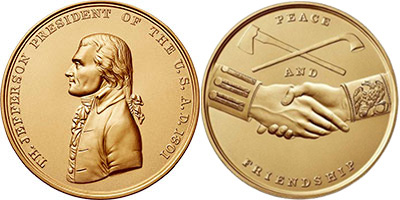 Commemorative coins differ from commemorative medals in several ways. First medals are not denominated in legal tender status, they have no stated value. Second, they are not restricted by law as to wording (such as must include "In God We Trust" or "Liberty"). Third, they may or may not be struck by the U. S. Mint. And last, they do not have the practical considerations such as wear patterns or stack-ability. But with non-numismatist they may seem the same or nearly the same.
Commemorative coins differ from commemorative medals in several ways. First medals are not denominated in legal tender status, they have no stated value. Second, they are not restricted by law as to wording (such as must include "In God We Trust" or "Liberty"). Third, they may or may not be struck by the U. S. Mint. And last, they do not have the practical considerations such as wear patterns or stack-ability. But with non-numismatist they may seem the same or nearly the same.
Thematically they are certainly collectible, such as all Presidents, or events like the Olympics, or historical events like World War II. They can also cut across geography and easily be collected worldwide on a theme.
Legal Stuff
Home
History
Our Collection
Exonumia
The Coin
Original Design
Modifications
Grading
Price Guide
The Carvers
Contact Us
The Carving
Coins by Grade
Sources
Commemoratives
Statistics
Variations
Final Design Issues
Production
Harvest Campaign
Copyright (c) Georgia 1832,LLLP 2018-2018
